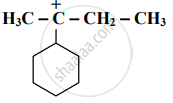Advertisements
Advertisements
प्रश्न
Distinguish between Inductive effect and resonance effect.
उत्तर
| Inductive effect | Resonance effect | |
| 1. | The presence of a polar covalent bond is required. | The presence of a conjugated π electron system or species having an atom carrying p orbital attached to multiple bonds is required. |
| 2. | The polarity is induced in adjacent carbon-carbon single (covalent) bonds due to the presence of an influencing group (more electronegative atom than carbon). | The polarity is produced in the molecule by the interaction of conjugated π bonds (or that between π bond and p orbital on the adjacent atom). |
| 3. | Depending on the nature of the influencing group it is differentiated as +I effect and -I effect. | Depending on the nature of the influencing group it is differentiated as +R and -R effect. |
| 4. | The direction of the arrow head denotes the direction of the permanent electron displacement. | The delocalisation of π electrons is denoted by using curved arrows. |
APPEARS IN
संबंधित प्रश्न
Find out the most stable species from the following. Justify.
`bar"C""H"_3, bar"C""H"_2"Br", bar"C""Br"_3`
Identify the α - carbons in the following species and give the total number of α-hydrogen.

Identify the α-carbon in the following species and give the total number of α-hydrogens.
\[\ce{CH2 = CH - CH2 - CH3}\]
Distinguish between Electrophile and nucleophile.
Distinguish between Homolysis and heterolysis.
Draw all the no-bond resonance structures of isopropyl carbocation.
Choose the correct option.
Which of the following statements are true with respect to electronic displacement in a covalent bond?
a. Inductive effect operates through π bond
b. Resonance effect operates through σ bond
c. Inductive effect operates through σ bond
d. Resonance effect operates through π bond
Predict the order of reactivity of the following compounds by SNl reaction mechanism.
\[\ce{\underset{\text{(I)}}{C6H5CH(C6H5)Cl}}\]
\[\ce{\underset{\text{(II)}}{C6H5CH2Cl}}\]
\[\ce{\underset{\text{(III)}}{C6H5C(CH3)(C6H5)Cl}}\]
Which of the following compound is highly reactive towards HCN?
Which of the following is NOT an electrophile?
Which of the following is the strongest nucleophile?
Which of the following statements is INCORRECT about hyperconjugation?
The +I inductive effect is shown by which of the following groups?
Which of the following alkyl groups shows least positive inductive effect?
How many tertiary carbon atoms and primary carbon atoms respectively are present in 2-iodo-3, 3- dimethyl pentane?
Which of the following is NOT an electrophile?
How many pi bonds and sigma bonds are present in following molecule?

Which of the following statements is not correct?
Identify the group that exerts electron withdrawing resonance effect.
Arrange the following free radicals in order of decreasing stability.
- Methyl
- Vinyl
- Allyl
- Benzyl
Identify the α-carbons in the following species and give the total number of α-hydrogen in it.
CH2 = CH − CH2 − CH3
Identify the α - carbons in the following species and give the total number of α-hydrogen.
\[\ce{CH3 - CH2 - \overset{⊕}{C}H - CH2 - CH3}\]
Identify the α - carbons in the following species and give the total number of α-hydrogen in each.
\[\ce{CH3 - CH2 - \overset{\oplus}{C}H -CH2 - CH2 }\]
Identify the α-carbon in the following species and give the total number of α-hydrogen.
\[\ce{CH2 = CH - CH2 - CH3}\]
Identify the α-carbons in the following species and give the total number of α-hydrogen.
CH2 = CH - CH2 - CH3
Identify the α-carbons in the following species and give the total number of α-hydrogen.
\[\ce{CH2 = CH - CH2 - CH3}\]
Identify the α - carbons in the following species and give the total number of α-hydrogen in each.
\[\ce{CH3 - CH2 - \overset{\oplus}{C}H - CH2 - CH3}\]
Identify the α - carbons in the following species and give the total number of α-hydrogen in each.
\[\ce{CH2 = CH - CH2 - CH3}\]
Identify the α-carbons in the following species and give the total number of α-hydrogen.
\[\ce{CH2 = CH - CH2 - CH3}\]
